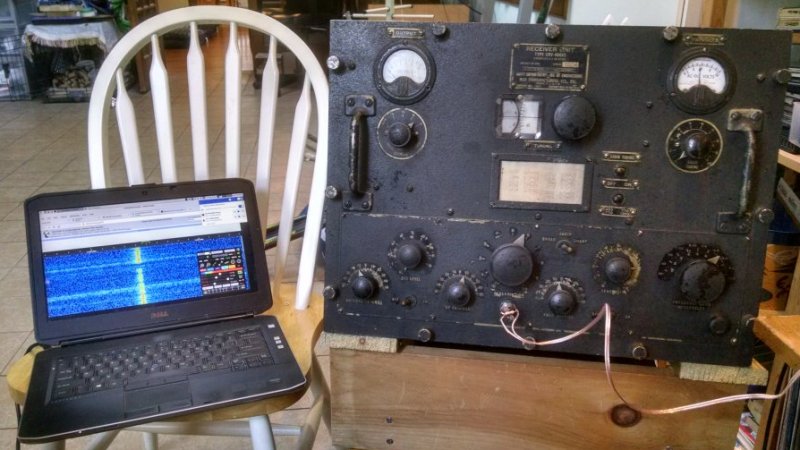

Designed for the United States Navy 87 years ago by engineers at the Radio Corporation of America (RCA), the RAL radio receiver consists at base of a tunable means of frequency-shifting to audio a narrow chunk of the electromagnetic spectrum centered from 300 kHz to 23 MHz—which facility is exactly the same basic-radio functionality provided by the most expensive "general-coverage" LF/MF/HF receiver we can buy in 2022.
Of course, any modern such receiver is, by comparison, refined to the point of absurdity. Any communication-quality modern receiver affords quartz-crystal-controlled tuning stability and includes direct frequency display; the RAL provides only a 1000-division logging scale (augmented, in its operating manual, by coarsely representative calibration graphs). Any modern general-coverage receiver also provides single-signal selectivity—a facility not so named because one signal is received at a time, but rather due to its characteristic of rejecting "the other side of zero beat" such that (for Morse code) a given signal is receivable at a given pitch at only one dial setting or (for AM radiotelephone reception) only the upper or lower sideband of a voice signal is received while the opposite sideband is rejected. And of course the dynamic range of a modern receiver—the range of signal strengths across which signals can be usefully received without either being masked by the receiver's internal noise or overdriving the receiver's circuitry such that reception no longer succeeds—is demonstrably, measurably better.
My particular RAL, an RAL-5 built by RCA in Camden, New Jersey, and weighing 69 pounds without its external power supply, bears serial number 1004 and a contract date of 26 December 1939. So it is that I assume that it was built in 1940, and is therefore 82 years old as I write this in April 2022. Also as I write, I'm using the RAL to listen to VOLMET aviation weather as transmitted in SSB suppressed-carrier AM radiotelephone by Gander Radio, Newfoundland, at 6604 kHz, just as later tonight I'll listen to the American Radio Relay League's Maxim Memorial Station, W1AW, transmitting, in Morse code, news of general interest to radio amateurs at 3581.5 kHz. Also possibly tonight or tomorrow night, but certainly no later than next Saturday morning's Vintage Radio Brass Pounders net at 7092 kHz, 0900 Eastern Time, I'll use the RAL-5, suitably augmented with outboard audio muting and RF input switching, for two-way Morse code communication as amateur radio W9BRD (Figure 1).

|

|
| Figure 1—Left: The RAL-5 receiver teamed with a laptop-delivered Web-accessible software defined radio (SDR) for two-way communication in the Vintage Radio Brass Pounders net. Using an SDR several states away helps when propagation causes signals from close-in net participants to skip over my location. Right: Side view of the RAL-5 on its chair stand. | |
My particular RAL suffered the misfortune of being twice submerged in basement flooding before I restored it to operation earlier this year. A few of its oil-filled capacitors had leaked; I replaced them. A few of its significant-dc-handling resistors had increased in value out of tolerance; I replaced them. But at last all my RAL-5 really needed for restoration to dependable usability was a thorough cleaning of its bandswitch contacts and variable-capacitor-rotor wipers with DeoxIT D5. Even its two D'Arsonval front-panel AF-output-level and tube-heater-voltage meters came back to life with internal cleaning.
As a regular user of MF/HF radio receiving technology that tends toward the simple and basic rather than the complex and overqualified, I consider the viability in 2022 of the six-vacuum-tube RAL-5—incredibly to some, a tuned-RF regenerative design rather than a superhet—to be profound. Its most expensive and highly refined modern equivalents do not, in my opinion, implement the basic-radio function of frequency-shifting to audio a narrow chunk of MF/HF-spectrum commensurately better than my 82-year-old implementation of 87-year-old technology. Modern receivers are more stable, better calibrated, more selective, more elegantly flexible and configurable, more uniform in characteristics, harder to mis-operate—and essentially inscrutable to and irreparable by their owners, who have long since been trained to mistake ramifying mere Fashion as Progress. Engaging with the RAL for practical radio reception in 2022 is to appreciate the clear ringing of an unadorned bell.
| Revised April 24, 02022. | Copyright © 2022 by David Newkirk (david.newkirk@gmail.com. All rights reserved. |
| home |